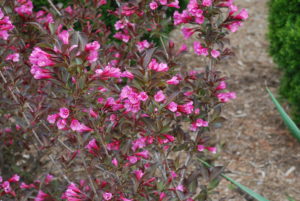Shredded umbrella plant (Syneilesis aconitifolia) is native to China, Korea, and Japan (USDA hardiness zones 5-7). The plant is often misidentified as mayapple (Podophyllum). The foliage is exquisitely dissected, similar to a finely dissected Japanese maple leaf. The plant serves a wonderful addition to any shade garden.
In mid-spring exquisite umbrella-like foliage emerges covered with hairy silver hairs. Umbrella-like pubescent leaves are very dissected and coated with tiny hairs. They stand 18 -24 inches tall atop sturdy stems. As the plant ages, pubescent hairs disappear and leaves turn deep forest green. After a brief number of years small plant colonies arise from underground rhizomes (2 feet wide in 5-7 years).
Flowers are very insignificant. Pinkish-white florets (each to ¼ inch across) bloom in June-July in corymbs atop striated purple stems that rise 3 feet or more above the foliage. Individual flowers are very small, and not interesting up close.
Shredded umbrella plants tolerate full shade, but perform best in dappled morning shade. Plants grow best in sun-dappled woodland conditions with moderate moisture, but will tolerate short dry spells of 2-3 weeks once the plants have adapted to their site, usually after the first year. Ideal garden environment is a humus-rich soil that is mulched with leaf compost. Humus supplies much of the needed nutrients.
Over the years shredded umbrella plants will naturalize via rhizomes to form colonies which widen out slowly. Plants are rarely purchased at garden centers. Shop at on-line nurseries which specialize on shade or woodland plants such as Plant Delights Nursery in NC and Fairweather Gardens in NJ.























